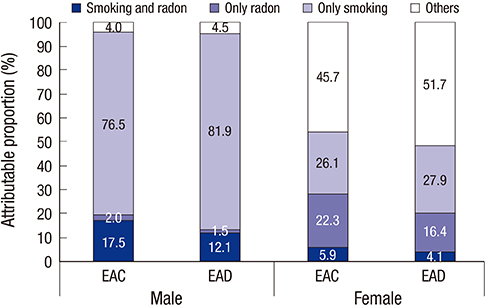J Korean Med Sci.
2015 May;30(5):542-548. 10.3346/jkms.2015.30.5.542.
Risks of Lung Cancer due to Radon Exposure among the Regions of Korea
- Affiliations
-
- 1Department of Preventive Medicine, School of Medicine, Ewha Womans University, Seoul, Korea. hpark@ewha.ac.kr
- 2Department of Social and Preventive Medicine, Inha University School of Medicine, Incheon, Korea.
- 3Ewha Clinical Trial Center, Ewha Womans University Medical Center, Seoul, Korea.
- KMID: 2155465
- DOI: http://doi.org/10.3346/jkms.2015.30.5.542
Abstract
- Radon is likely the second most common cause of lung cancer after smoking. We estimated the lung cancer risk due to radon using common risk models. Based on national radon survey data, we estimated the population-attributable fraction (PAF) and the number of lung cancer deaths attributable to radon. The exposure-age duration (EAD) and exposure-age concentration (EAC) models were used. The regional average indoor radon concentration was 37.5 95 Bq/m3. The PAF for lung cancer was 8.3% (European Pooling Study model), 13.5% in males and 20.4% in females by EAD model, and 19.5% in males and 28.2% in females by EAC model. Due to differences in smoking by gender, the PAF of radon-induced lung cancer deaths was higher in females. In the Republic of Korea, the risk of radon is not widely recognized. Thus, information about radon health risks is important and efforts are needed to decrease the associated health problems.
Keyword
MeSH Terms
Figure
Cited by 2 articles
-
The Disease Burden of Lung Cancer Attributable to Residential Radon Exposure in Korean Homes
Jong-Hun Kim, Mina Ha
J Korean Med Sci. 2018;33(29):. doi: 10.3346/jkms.2018.33.e223.Indoor Radon and Lung Cancer: Estimation of Attributable Risk, Disease Burden, and Effects of Mitigation
Si-Heon Kim, Sang-Baek Koh, Cheol-Min Lee, Changsoo Kim, Dae Ryong Kang
Yonsei Med J. 2018;59(9):1123-1130. doi: 10.3349/ymj.2018.59.9.1123.
Reference
-
1. National Statistical Office of Korea. 2012 Annual report on the cause of death statistics. Dae Jeon: Korea National Statistical Office;2013. accessed on 13 March 2014. Available at http://kostat.go.kr/portal/korea/kor_nw/2/1/index.board?bmode=read&aSeq=308559.2. World Health Organization. WHO handbook on indoor radon: a public health perspective. Geneva: World Health Organization;2009. accessed on 21 February 2014. Available at http://whqlibdoc.who.int/publications/2009/9789241547673_eng.pdf.3. International Agency for Research on Cancer. Man-made mineral fibers and radon. IARC Working Group on the Evaluation of Carcinogenic Risks of Humans. Vol. 43. Lyon: WHO Press;1988.4. Kim Y, Chang BU, Park HM, Kim CK, Tokonami S. National radon survey in Korea. Radiat Prot Dosimetry. 2011; 146:6–10.5. Catelinois O, Rogel A, Laurier D, Billon S, Hemon D, Verger P, Tirmarche M. Lung cancer attributable to indoor radon exposure in France: impact of the risk models and uncertainty analysis. Environ Health Perspect. 2006; 114:1361–1366.6. Hänninen O, Knol AB, Jantunen M, Lim TA, Conrad A, Rappolder M, Carrer P, Fanetti AC, Kim R, Buekers J, et al. EBoDE Working Group. Environmental burden of disease in Europe: assessing nine risk factors in six countries. Environ Health Perspect. 2014; 122:439–446.7. Peterson E, Aker A, Kim J, Li Y, Brand K, Copes R. Lung cancer risk from radon in Ontario, Canada: how many lung cancers can we prevent? Cancer Causes Control. 2013; 24:2013–2020.8. Veloso B, Nogueira JR, Cardoso MF. Lung cancer and indoor radon exposure in the north of Portugal--an ecological study. Cancer Epidemiol. 2012; 36:e26–e32.9. Committee on Health Risks of Exposure to Radon, Board on Radiation Effects Research, Commission on Life Sciences, National Research Council. Health Effects of Exposure to Radon. Washington, DC: National Academy Press;1999. (BEIR; 6).10. Darby S, Hill D, Auvinen A, Barros-Dios JM, Baysson H, Bochicchio F, Deo H, Falk R, Forastiere F, Hakama M, et al. Radon in homes and risk of lung cancer: collaborative analysis of individual data from 13 European case-control studies. BMJ. 2005; 330:223.11. Lim SS, Vos T, Flaxman AD, Danaei G, Shibuya K, Adair-Rohani H, Amann M, Anderson HR, Andrews KG, Aryee M, et al. A comparative risk assessment of burden of disease and injury attributable to 67 risk factors and risk factor clusters in 21 regions, 1990-2010: a systematic analysis for the Global Burden of Disease Study 2010. Lancet. 2012; 380:2224–2260.12. Jee SH, Samet JM, Ohrr H, Kim JH, Kim IS. Smoking and cancer risk in Korean men and women. Cancer Causes Control. 2004; 15:341–348.13. Murray CJ, Ezzati M, Lopez AD, Rodgers A, Vander Hoorn S. Comparative quantification of health risks conceptual framework and methodological issues. Popul Health Metr. 2003; 1:1.14. United States Environmental Protection Agency. Assessment of risks from radon in homes. Washington, DC: United States Environmental Protection Agency;2003. accessed on 1 April 2014. Available at http://www.epa.gov/radon/risk_assessment.html.15. Turner MC, Krewski D, Chen Y, Pope CA 3rd, Gapstur S, Thun MJ. Radon and lung cancer in the American Cancer Society cohort. Cancer Epidemiol Biomarkers Prev. 2011; 20:438–448.16. Menzler S, Piller G, Gruson M, Rosario AS, Wichmann HE, Kreienbrock L. Population attributable fraction for lung cancer due to residential radon in Switzerland and Germany. Health Phys. 2008; 95:179–189.17. Chen J, Moir D, Whyte J. Canadian population risk of radon induced lung cancer: a re-assessment based on the recent cross-Canada radon survey. Radiat Prot Dosimetry. 2012; 152:9–13.18. Organization for Economic Cooperation and Development. OECD health statistics. 2013. accessed on 1 April 2014. Available at http://www.oecd-ilibrary.org/social-issues-migration-health/data/oecd-health-statistics_health-data-en.19. Turner MC, Krewski D, Chen Y, Pope CA 3rd, Gapstur SM, Thun MJ. Radon and COPD mortality in the American Cancer Society Cohort. Eur Respir J. 2012; 39:1113–1119.20. Turner MC, Krewski D, Chen Y, Pope CA 3rd, Gapstur SM, Thun MJ. Radon and nonrespiratory mortality in the American Cancer Society cohort. Am J Epidemiol. 2012; 176:808–814.21. Neri A, Stewart SL, Angell W. Radon control activities for lung cancer prevention in national comprehensive cancer control program plans, 2005-2011. Prev Chronic Dis. 2013; 10:E132.22. Korean Ministry of Environment. Guideline of indoor radon reduction. Seoul: Korean Ministry of Environment;2010. accessed on 21 February 2014. Available at http://www.me.go.kr/home/web/index.do?menuId=12.



